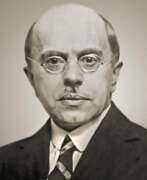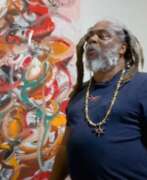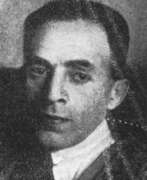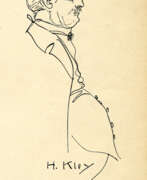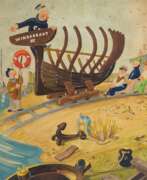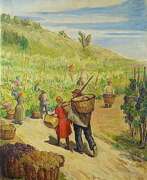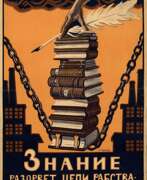Cartoonists 20th century


Henri-Georges Adam was a French engraver and non-figurative sculptor of the École de Paris, who was also involved in the creation of numerous monumental tapestries. His work in these three areas is regarded as among the most extensive of the twentieth century.
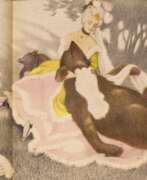

Moritz Bauernfeind was an Austrian painter, graphic artist, illustrator and cartoonist.
Moritz studied at the Academies of Fine Arts in Vienna and Munich, then at the Académie Julian in Paris, early landscapes painted in the style of Impressionism.
Bauernfeind gained fame in the early 20th century as an illustrator of political satire, notably in Meggendorfer's Humorous Notes and Der Flo. Between 1900 and 1905 he published more than 200 satirical drawings in Der Scherer and Simplicissimus, and in 1909 a series in the Illustrirten Zeitung in Leipzig. And color illustrations for fairy tales and legends were eagerly published by juvenile and many other publications. Bauernfeind's fantastic genre images with stylized figures and a touch of burlesque attract with their unusualness and mystery.


Quentin Saxby Blake is an English cartoonist, caricaturist, illustrator and children's writer. He has illustrated over 300 books, including 18 written by Roald Dahl, which are among his most popular works.[a] For his lasting contribution as a children's illustrator he won the biennial international Hans Christian Andersen Award in 2002, the highest recognition available to creators of children's books. From 1999 to 2001, he was the inaugural British Children's Laureate. He is a patron of the Association of Illustrators.


Johan Coenraad Braakensiek was a Dutch painter, illustrator and political cartoonist. For most of his career, Braakensiek worked for a number of publishers as an illustrator. However, he also found work as a political cartoonist for the magazines Geïllustreerd Politie-Nieuws, De Amsterdammer and De Groene Amsterdammer. His first work was with Geïllustreerd Politie-Nieuws where he contributed infrequently. His break and rise in popularity came in 1886 when he was made the political cartoonist for De Amsterdammer magazine. He also was affiliated with De Groene Amsterdammer magazine from 1925 to 1931. Braakensiek remains popular thanks to the books he worked on as illustrator. Books such as Van Allerlei Slag and Uit het leven van Dik Trom, which feature his art are widely known and read.


Raymond Redvers Briggs was a British writer, illustrator, and cartoonist.
A professional illustrator, he worked on the design of children's books. In the 1960s, Briggs discovered his talent and ability to combine words and pictures, using a form of strip cartooning that defined his later work.
Briggs is best known for his wordless book The Snowman, published in 1978, a sort of cute children's tale but with deep meaning. The animated and musical versions of this book are popular in Britain and are shown annually at Christmas.


Orville Bulman is a self-taught American artist and former businessman. After working briefly as a cartoonist in Chicago and becoming president of two family-owned companies, he was inspired by the lives of the African-American people of Haiti and the Caribbean islands. Bulman created some 2,000 paintings depicting the flora and fauna of those places and scenes of people's lives.


Stanisław Wincenty Chlebowski is a Polish impressionist painter and illustrator. His main themes are still lifes, floral compositions, genre scenes and landscapes, in particular views of Gdańsk and its surroundings. His paintings are in the collections of the National Museum in Gdańsk and the National Maritime Museum in Gdańsk.
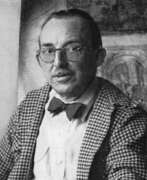

Dean Cornwell was an American illustrator and muralist. His oil paintings were frequently featured in popular magazines and books as literary illustrations, advertisements, and posters promoting the war effort. Throughout the first half of the 20th century he was a dominant presence in American illustration. At the peak of his popularity he was nicknamed the "Dean of Illustrators". He began his professional career as a cartoonist for the Louisville Herald. Soon thereafter he moved to Chicago, where he studied at the Art Institute and worked for the Chicago Tribune. Cornwell's paintings were in Cosmopolitan, Harper's Bazaar, Redbook, and Good Housekeeping magazines. He painted murals for the Los Angeles Public Library, the Lincoln Memorial Shrine in Redlands, California etc. Cornwell taught and lectured at the Art Students League in New York. He served as president of the Society of Illustrators from 1922 to 1926, and was elected to its Hall of Fame in 1959.


Miguel Covarrubias, also known as José Miguel Covarrubias Duclaud was a Mexican painter, caricaturist, illustrator, ethnologist and art historian. Along with his American colleague Matthew W. Stirling, he was the co-discoverer of the Olmec civilization.


Heinrich Danioth was a Swiss painter and poet.
Some of Danioth’s most notable works include the murals, "Tellsprung" and "Rütlischwur", on the walls of the Tellspielhaus, an Altdorf theatre, in 1927.
He painted the mural “Fundamentum” in 1936. It is currently located at the Federal Letter Museum, one of three historical museums in Schwyz, Switzerland.
Another notable work is the large-format mural "Föhnwacht", created on behalf of the Federal Art Commission.


Aleksandr Aleksandrovich Deyneka (Russian: Алекса́ндр Алекса́ндрович Дейне́ка) was a Soviet Russian artist, celebrated for his significant contribution to the world of modernist figurative painting in the first half of the 20th century. Born into a Ukrainian origin, Deyneka's artistry spanned painting, graphic design, and sculpture, leaving an indelible mark on Russian modernism. His works, characterized by vivid movement and an innovative portrayal of the Soviet lifestyle, include iconic pieces such as "The Defense of Sevastopol," "Collective Farmer on a Bicycle," and "Future Pilots," which showcase the dynamism and spirit of the Soviet era. Deyneka's commitment to Social Realism—a style aimed at the accessible portrayal of everyday life—earned him both national and international acclaim. His murals and mosaics for public buildings and metro stations in Moscow, like the Mayakovskaya station, underline his influence on the Soviet visual landscape and contribute to his legacy as a pioneer of a style that bridged European innovation with Soviet themes.
Deyneka's journey began with his education at the VHUTEMAS, where he was influenced by figures such as Mayakovsky, which shaped his approach to art as a tool for societal influence and expression. His artworks, permeated with themes of labor, sports, and a forward-looking optimism, reflect the Soviet Union's utopian ambitions and the complexities of its societal structure. Notably, Deyneka's "Mother" stands out as a powerful symbol of the Soviet woman, intertwining high social awareness with the natural role of motherhood, highlighting the artist's nuanced approach to depicting Soviet life.
Throughout his career, Deyneka remained a formidable figure in art, navigating through various artistic societies and contributing to magazines and posters that defined the visual narrative of the Soviet Union. His travels to Italy, France, and the US broadened his perspective, enriching his work with international influences while retaining his distinct stylistic identity. Deyneka's decorations for the Moscow Metro not only won prestigious awards but also immortalized his vision of Soviet progress and optimism, capturing the essence of an era poised between grand aspirations and complex realities.
For art collectors and enthusiasts of Russian modernism, Deyneka's works offer a window into the vibrancy and ideological fervor of the Soviet Union, embodying the era's aesthetic and thematic aspirations. His contributions to the public and artistic spheres underscore the role of art in shaping and reflecting societal values, making his oeuvre a vital point of study for anyone interested in the intersections of art, history, and society.
To stay informed about exhibitions and auctions featuring Aleksandr Aleksandrovich Deyneka's work, sign up for updates. This subscription ensures you're always in the know about new sales and events related to this iconic artist, allowing you to deepen your appreciation and possibly enhance your collection.


Paul Dom, born Paulus Ludovicus Carolus Dom, was a Belgian and Dutch painter and illustrator.
He studied at the Royal Academy of Fine Arts in Antwerp, lived in Belgium and the Netherlands, was granted Dutch citizenship in 1936 and lived in The Hague for the rest of his life.
Paul Dom was a versatile artist. He dabbled in drawing and painting and painted portraits, cityscapes and sketches, and genre scenes. At the same time he was a political cartoonist and illustrated books. Between 1917 and 1956 Dom illustrated hundreds of books, mostly for children.


Simon English is a contemporary british artist. He is best known for his large and small-scale 'painted drawings' in which he mingles his distinctive imagery and words. He moves lightly between tight draftsmanship and a playfully sloppy application of colour and line. Language is paramount with diaristic musings interspersed with song lyrics, poetry and humorous one-liners. Self-described as 'automatic', his work has the spontaneity of stream-of-consciousness, exploring themes of love and loss, as well as gay and popular culture. Simon English lives and works in London. He emerged on the London Art scene in 1994 with an exhibition of paintings at the Saatchi Gallery as part of Young British Art III. Simon has exhibited internationally at numerous institutions.


Alois Erbach was a German graphic artist and painter.
In his painterly works, Erbach was initially oriented towards Expressionism. Later works show influences of Surrealism and New Objectivity.
Erbach was at least close to the KPD and was a member of the Association of Revolutionary Visual Artists ASSO, the Red Group and the group "Die Zeitgemäßen" Under the pseudonym "Aleus" or "Marc Aleus", Erbach supplied caricatures for the Rote Fahne and the satirical magazines Knüppel, Die Pleite and Eulenspiegel.
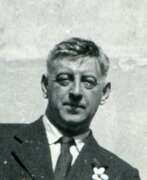

Pierre Falké, full name Pierre André Michel Falké, was a French painter and printmaker, illustrator and cartoonist.
Pierre Falké was a well-known humorist in the French press in the first half of the 20th century, collaborating with popular humor and satirical magazines. He drew comic strips and caricatures. In painting, Falké specialized mainly in marine views. He also illustrated more than sixty books and practiced wood engraving.


Lyonel Charles Adrian Feininger was an American-German artist renowned for his unique integration of Expressionism, Cubism, and Bauhaus principles. His body of work, which spans several critical decades in modernism's development, is celebrated for its distinctive blend of architectural and nautical motifs, articulated through planar shifts and jagged lines of Cubism, with a vibrant Orphist color palette.
Lyonel Feininger's journey as an artist began in earnest when he was 36, becoming a pivotal figure in various German expressionist groups and a founding member of the Bauhaus, where he led the printmaking workshop. His art, which also includes significant contributions to caricature and photography, explores the intricate relationship between humanity and industrialization, evident in his depictions of architectural and mechanized forms.
His work was subject to Nazi criticism, being labeled as "degenerate," which led to his return to the United States, where he continued to evolve his artistic style. Posthumously, Lyonel Feininger's art has been the focus of several retrospectives, and his pieces, like "Jesuits III," continue to fetch high figures at auctions, underscoring his lasting impact on the art world.
Notably, Lyonel Feininger's "Cathedral" woodcut, representing the Bauhaus's utopian vision, remains one of his most iconic works, symbolizing the integration of art and craftsmanship with its avant-garde yet traditional approach. His legacy is further carried by his sons, Andreas and T. Lux Feininger, who also made their marks in the arts.
For collectors and art and antiques experts, Feininger's work represents a fascinating intersection of various art movements and a testament to the enduring nature of expressive and innovative artistry. To stay updated on new product sales and auction events related to Lyonel Feininger, consider signing up for updates, ensuring you're informed about the latest opportunities to engage with his enduring legacy.


Arthur (Usher) Fellig, known by his pseudonym Weegee, was a photographer and photojournalist, known for his stark black and white street photography in New York City.
Weegee worked in Manhattan's Lower East Side as a press photographer during the 1930s and 1940s and developed his signature style by following the city's emergency services and documenting their activity. Much of his work depicted unflinchingly realistic scenes of urban life, crime, injury and death. Weegee published photographic books and also worked in cinema, initially making his own short films and later collaborating with film directors such as Jack Donohue and Stanley Kubrick.


Paul Flora was an Austrian cartoonist, graphic artist, and illustrator known for his skill with pen and ink.
Flora's work has appeared in the famous New York Times and The Observer newspapers, and his drawings have graced the stamps of Liechtenstein and Austria. Paul Flora has been one of Europe's most famous illustrators since the 1960s.
He also produced books, films and sets.


Jean-Louis Forain was a French painter, graphic artist and book illustrator.
Jean-Louis Forain began his career as a cartoonist. He worked for several Parisian magazines including Le Monde Parisien and Le rire satirique. Later studied at the École des Beaux-Arts with Jean-Baptiste Carpeaux and Jean-Léon Gérôme. He was friends with Paul Verlaine, Arthur Rimbaud, Claude Monet, Edouard Manet and Edgar Degas.
Jean-Louis Forain is best known for his keen observations on Parisian society, especially its social and political scenes. His subjects were often cabarets, theatres, cafés and the bustling streets of Paris. He depicted life of the working class, the bourgeoisie and the upper class with a satirical and critical eye.
Forain's artistic style was characterised by bold brushwork, strong use of line and a limited colour palette. His works often depicted scenes with dynamic movement, conveying the energy and atmosphere of the moment. His paintings were often theatrical in character, reflecting his interest in the world of entertainment.


Josef Nikolaus Geis was a German graphic artist, painter, and illustrator, renowned for his contributions to the art scene in Munich. Known for his vivid posters and illustrations, Geis had a distinctive style that often captured the socio-political climate of early 20th-century Germany. His work frequently featured in Munich-based publications such as "Jugend" and "Simplicissimus," as well as the humor magazine "Fliegende Blätter."
Geis's art is not only noted for its aesthetic quality but also for its historical significance, reflecting the tumultuous times during the Weimar Republic and the early years of Nazi Germany. His posters, such as those encouraging voting for social democrats, are particularly noted for their bold colors and striking compositions. This has made his works significant both culturally and historically, finding places in art auctions and collectors' portfolios worldwide.
His legacy is preserved through collections and exhibitions in various museums, and his works continue to be discussed and sold in art circles, highlighting his lasting impact on German art history. For those interested in the intersection of art and history, Josef Geis's works offer a compelling glimpse into Germany's past through the lens of visual culture.
For collectors and art experts, staying informed about Josef Geis's artwork and related auction events can provide valuable insights into the evolution of graphic arts and its market value. If you wish to receive updates and notifications about new sales and auctions featuring Josef Geis, consider signing up for specialized newsletters.
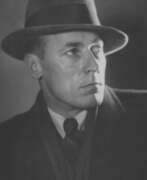

Jazep Mikhailovich Gorid (Russian: Язеп Михайлович Горид) was a Belarusian and Polish-Lithuanian artist of the first half of the twentieth century. He is known as a graphic artist and painter, caricaturist and illustrator.
Jazep Gorid drew political and everyday caricatures, painted portraits and landscapes. He also worked in book graphics, illustrated and designed books and other printed publications. In addition, the artist created stained-glass windows and murals.


Vitaly Nikolaevich Goryaev (Russian: Виталий Николаевич Горяев) was a celebrated Soviet graphic artist, illustrator, painter, and caricaturist, born on April 14, 1910, in Tobolsk province, and passed away on April 12, 1982, in Moscow. He embarked on his artistic journey after his family moved to Chita in 1921, where he first published his drawings in the local newspaper. Goryaev's notable achievements include first-degree diplomas at the All-Union Contests "Best Books" for his illustrations to "The Adventures of Huckleberry Finn" and Gogol's "Petersburg Stories". His work was also internationally recognized, evidenced by a diploma II degree at the International Book Exhibition in Bratislava in 1967 for "Petersburg Stories", and in 1969, he was awarded the Gold Medal of the Czechoslovak Union of International Relations. Goryaev's illustrations spanned works by Russian classics like Pushkin, Gogol, and Dostoevsky, contributing significantly to the visual representation of these literary giants' works.
A laureate of the State Prize of the USSR (1967) for his contributions to illustrating Gogol's "Petersburg Stories", Goryaev was honored with the title of People's Artist of the RSFSR in 1976, and later, People's Artist of the USSR in 1981, marking his significant contributions to Soviet art. His legacy includes a profound impact on the illustration of literature, with his works being housed in prestigious collections such as the State Tretyakov Gallery, the Russian Museum, and the Pushkin Museum of Alexander Pushkin.
Goryaev's style was known for its expressive detail and ability to capture the essence of the literary works he illustrated, making his art an integral part of Soviet visual culture. His son, Sergei Vitalevich Goryaev, continues the artistic lineage as an artist, preserving the family's contribution to Russian art.
For collectors and experts in art and antiques, Goryaev's works represent a unique intersection of Soviet history, literature, and visual arts, offering a glimpse into the rich cultural tapestry of the era. His illustrations are not only important for their artistic value but also for their historical significance, embodying the spirit and challenges of Soviet society.
To stay updated on events, sales, and auctions related to Vitaly Nikolaevich Goryaev's work, sign up for updates. This subscription ensures you remain informed about opportunities to acquire pieces of this influential artist's legacy, highlighting moments when his works become available in the market.


Richard Graef was a German painter, graphic artist, illustrator and cartoonist.
Graef studied painting at Hans von Hayek's school in Dachau, and then went to Paris for further studies, and afterwards opened his own studio in Dachau with his wife. Graef achieved fame as an illustrator and cartoonist, whose subjects - human vices and weaknesses, the relationship of the rich and poor and so on. He is one of the most famous and prolific cartoonists of the satirical weekly Simplicissimus and one of the oldest members of the Dachau artist colony at the time.
Graef also mastered wood engraving, but over time turned increasingly to watercolor and oil painting, creating still lifes and portraits as well as landscape paintings.


William Gropper was an American cartoonist, lithographer, and graphic artist who studied under Robert Henry and George Bellows. As a socialist, he spent his life creating satirical images about greed and exploitation, war, and prejudice. The artist visited the USSR in the 1920s, and the main subjects of his work in the 1930s were the international labor movement and anti-fascist cartoons. He collaborated with many Communist-oriented American publications. Glopper is known not only for his caricatures, but also for his book illustrations, posters, monumental and easel paintings.


Friederike Groß is a German painter, caricaturist and university teacher who lives and works as a freelance artist in Stuttgart.
Friederike Groß studied free graphics and art education with Dieter Groß at the State Academy of Fine Arts Stuttgart from 1984 to 1989. Since 1985, Friederike Groß has worked as a caricaturist for the Stuttgarter Zeitung.
From 2008 to 2014, Friederike Groß taught as a lecturer in drawing at the Swiss Federal Institute of Technology (ETH) in Zurich. Since 2013, she has held a professorship for illustration at the Berlin Technical University of the Arts (BTK) at the campus in Hamburg.


Rudolf Grossmann (German: Rudolf Grossmann, or Großmann), full name Rudolf Wilhelm Walther Grossmann, was a German painter, draftsman, illustrator and graphic artist.
Born into an artistic family, Grossmann began his education in painting and printmaking at the Düsseldorf Academy before continuing his studies in Paris with Lucien Simon and Pouleroz. Among his best-known works are various portrait drawings of celebrities, notably those published in the satirical periodical Simplicissimus; he was also known for his book illustrations. Grossmann began publishing his prints in 1905, and many major publishers in Germany and France commissioned his work. He later concentrated on figurative works and urban scenes, which showed the influence of Cézanne and Pasquin.
From 1928 until Hitler's Nazi Party came to power, Grossmann taught at the Berlin Royal School of Art and was a member of the Berlin Secession and the Deutsche Kunstlerbund. In 1934, his work, like that of many of his colleagues, was stigmatized as degenerate and confiscated by the Nazi government, and he was disbarred from practicing his profession. He soon left for Freiberg im Beisgau, where he died on November 28, 1941.


Albert Guillaume was a French artist, cartoonist, illustrator, and master of the poster.
Guillaume was a prolific illustrator: he worked for magazines, books, and almanacs, and his satirical drawings were published in Parisian humor magazines. He was also a painter and designer of theater posters and advertising posters. Working for the large Parisian printing company Camis, he designed a series of highly successful posters for commercial goods.


Albert Pieter Hahn was a Dutch political cartoonist, poster artist and book cover designer; well known for his socialist and antimilitaristic viewpoints. Some of his drawings, especially those of the railroad strikes of 1903, have been regularly used in history textbooks. His son-in-law, Albert Hahn jr., was also an artist, so he is sometimes referred to as "Sr.".


Edmund Harburger was a German artist of the last third of the nineteenth and early twentieth centuries. He is known as a painter, graphic artist, illustrator, and caricaturist.
Harburger became famous for more than 1,500 humorous drawings for the magazine Fliegende Blätter. He also created book illustrations and political cartoons. After living for two years in Venice, the artist practiced there copying the works of the old masters. His exhibitions were held in various European cities, including Paris, Berlin and Munich. His works are kept in museums in various countries, including the New Pinakothek in Munich and museums in Gdansk, Leipzig, Prague and other cities.


Kurt Heiligenstaedt, born on 13 August 1890 in Roßleben, Germany, was a distinguished artist known for his contributions as a poster designer, commercial graphic artist, and caricaturist. He is particularly recognized for his work with the German magazine "Simplicissimus," where he regularly contributed his drawings starting from 1923/1924 and then more consistently from 1935 onwards. In total, "Simplicissimus" published 428 of his drawings, highlighting his prolific output and significant role in the magazine.
Heiligenstaedt specialized in naturalistic yet elegantly drawn erotic scenes in contemporary costumes, which were among the first Pin-up images in Germany. His work for the successor magazine to "Simplicissimus" in 1959 was notable for causing a rare seizure action at the time due to the depiction of suggested nipples on a cover image.
He passed away in 1964 at the age of 73 in Berlin and was buried at the Waldfriedhof Zehlendorf, although his grave is no longer preserved. Heiligenstaedt's artistic style and his contributions to graphic design and caricature make him a notable figure in the history of German art.
Kurt Heiligenstaedt's work remains relevant for collectors, auctioneers, and experts in art and antiques, reflecting a unique blend of commercial artistry and illustrative skill. His legacy continues to inspire contemporary artists and designers.
For those interested in staying updated on events and sales related to Kurt Heiligenstaedt’s works, signing up for relevant newsletters and updates would be beneficial. This ensures staying informed about new discoveries and opportunities related to his art.
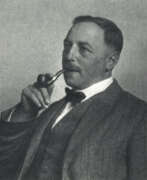

Thomas Theodor Heine was a German-Swedish artist of late nineteenth and early twentieth centuries of Jewish origin. He is known as a painter, draftsman, illustrator and writer.
Heine co-founded the popular German satirical weekly Simplicissimus, where he printed his drawings and caricatures. He also collaborated with the magazines Flying Pages and Youth, illustrated books, and created advertising posters and erotic drawings. After the Nazis came to power, the artist fled to Sweden, where he obtained citizenship. His works were presented at a retrospective anniversary exhibition in Stockholm in 1947, a year before Heine's death.


Adolf Hengeler was a German artist and illustrator, renowned for his distinctive style that beautifully merged humor with meticulous detail. Born on February 11, 1863, in Kempten, Allgäu, Hengeler's journey in the arts led him to Munich, where he left an indelible mark on the art and culture of the era.
Hengeler's body of work is diverse, encompassing applied graphics, caricatures, and picture stories. His graphic work, ranging from airy color drawings to precise ink strokes, has often been compared to Wilhelm Busch for its unique charm and precision. Notably, Hengeler regularly contributed to the "Fliegende Blätter" and created popular publications like the "Münchner Kinderfibel" and the "Kriegstagebuch 1914/15".
In painting, Hengeler focused on landscapes, often featuring cherubs and mythical creatures, and idyllic scenes of people in landscapes. His paintings are characterized by earthy brown tones, highlighted by bright local and pastel tones in flesh, clothing, or flowers, capturing the beauty of nature in Oberbayern and Allgäu. In his later years, Hengeler turned to Christian legends and biblical figures, adding a spiritual dimension to his natural scenes.
Hengeler's legacy is preserved in the Museum der Stadt Kempten, as per the bequest of his grandson, the art historian Peter von Bomhard. The museum houses Hengeler's personal and artistic belongings, including furniture and portraits, in a dedicated Hengeler Room.
For collectors, auctioneers, and experts in art and antiques, Adolf Hengeler's work offers a unique window into the culture and art of his time. His contributions to the German art scene, especially through his distinctive style and thematic diversity, make his works highly valued and sought after.
For those interested in staying updated on new product sales and auction events related to Adolf Hengeler's works, we invite you to sign up for our updates. This subscription is tailored specifically to keep you informed about relevant events and opportunities in the world of Adolf Hengeler's art.


Harold Brocklebank Herbert was an early 20th century Australian painter and printmaker, an illustrator and cartoonist. A traditionalist, as an art teacher he promoted representational painting, and as a critic was an influential detractor of modernism. He was the first war artist to be appointed for Australia in the Second World War, serving for 6 months with the Australian Infantry Forces in Egypt in 1941 and in the Middle East in 1942. Herbert continued the Australian impressionist style and exercised particular skill with watercolour washes and his etchings, lithographs and cartoons are in an economical, sketchy style.


Adolf Hoffmeister (1902-1973) was a Czech artist, writer, journalist, playwright, translator, and diplomat, renowned for his multifaceted contributions to culture and art. His early career saw him collaborate with significant figures in the art world, including Philippe Soupault and Jaroslav Ježek. In 1928, Hoffmeister made his mark with a solo exhibition in Paris and became involved in various literary and artistic publications, such as Lidové noviny and Literární noviny.
Hoffmeister's art often intersected with his political views. He set up the anti-fascist magazine Simplicus in the 1930s and was a member of the Mánes Association of Fine Arts, where he defended the anti-Nazi artwork of John Heartfield. His life was dramatically affected by World War II; fleeing Nazism, he was interned in Paris and a Moroccan concentration camp before reaching New York in 1941. After the war, he returned to Prague and engaged in diplomacy and academia but faced political ostracization following his pro-reform activities in 1968.
Hoffmeister's work in collage was notable, especially his illustrations for Jules Verne's "Around the World in Eighty Days." He was also known for his libretto for the children's opera "Brundibar" and translating James Joyce’s "Anna Livia Plurabelle." His pieces, such as "Demonstration" (1963) and "Greek village by Syrakus" (1960), are preserved in archives like the Ruth and Marvin Sackner Archive of Concrete and Visual Poetry, illustrating his unique approach to visual storytelling.
For collectors, auctioneers, and art and antiques experts, Hoffmeister's works represent a compelling blend of artistic innovation and historical context. His legacy continues to inspire, and keeping informed about exhibitions or sales of his work is essential for those interested in 20th-century European art and literature.


Dieter Huthmacher, born in 1947 in Pforzheim, Germany, is a renowned artist celebrated for his contributions to the world of fine art. His creative journey is marked by a diverse array of print graphics, where he skillfully blends color and form to create captivating works. Huthmacher's art is not only a reflection of his mastery in various techniques but also a testament to his deep understanding of artistic expression.
Throughout his career, Huthmacher has explored different themes and motifs, often experimenting with large formats and various color techniques. His works, primarily consisting of prints, have been featured in several auctions, indicating the consistent interest and value placed on his art in the collectors' market. Notable pieces like "Thalia," created around 1988, showcase his proficiency in color woodcut techniques and are representative of his artistic signature.
Dieter Huthmacher's works continue to be sought after, with auctions featuring over 25 graphic prints of various motifs, demonstrating his versatility and appeal in the art world. His creations have been presented in prestigious auction houses, resonating with collectors, auctioneers, and art enthusiasts alike.
For those interested in the world of art and antiques, particularly in the works of Dieter Huthmacher, staying informed about upcoming auctions and sales can be incredibly beneficial. By signing up for updates, you can receive timely information about new product sales and auction events related to Dieter Huthmacher's art, ensuring you never miss an opportunity to acquire a piece of his esteemed collection.


Angelo Jank was a German animal painter, illustrator and member of the Munich Secession. He was the son of the German painter Christian Jank and specialized in scenes with horses and riders. For many years, he was also employed as an illustrator for the magazines Jugend and Simplicissimus, And he was also an instructor at the Academy of Fine Arts. In addition to his canvases, he painted murals at the Justizpalast and scenes from history at the Reichstag building in Berlin. His work was also part of the painting event in the art competition at the 1936 Summer Olympics.


Aminadav Moiseyevich Kanevsky (Russian: Аминадав Моисеевич Каневский) was a Russian graphic artist and illustrator, celebrated for his satirical works and contributions to children's literature. Born into a large family in Elisavetgrad, Kherson province (now Kropyvnytskyi), Ukraine, in 1898, Kanevsky's early life was marked by poverty, prompting him to work from a young age in various capacities, including as a photographer's assistant and factory worker. His talent in art led him to Moscow's VKHUTEMAS, where under the guidance of Dmitry Moor, he honed his skills in cartooning and illustration, eventually becoming a prominent figure in Soviet satirical and children's publications.
Kanevsky's notable contributions include the creation of the iconic character Murzilka for children's literature, and his illustrations for "The Golden Key" by Alexei Tolstoy and "Moidodyr" by Korney Chukovsky. His work extended beyond books to satirical magazines and posters, where he depicted political themes and everyday Soviet life with humor and insight. During the Great Patriotic War, he produced anti-Nazi propaganda, showcasing his commitment to the Soviet cause through art.
Kanevsky's legacy is preserved in the State Tretyakov Gallery, the State Russian Museum, and other prestigious collections, affirming his enduring impact on Russian cultural and artistic heritage. His artworks, often executed in ink or watercolor, continue to attract collectors, with auction prices reflecting the significant interest in his oeuvre.
For enthusiasts and collectors of Aminadav Kanevsky's work, signing up for updates can provide valuable information on new sales and auction events related to his creations. This ensures that aficionados do not miss out on the opportunity to acquire pieces by this remarkable artist, whose work spans the humorous to the historically significant.


Felix Runcie Kelly was a New Zealand-born graphic designer, painter, stage designer, interior designer and illustrator who lived the majority of his life in the United Kingdom. He sometimes signed his illustration and cartoon work Fix.


Porfiry Nikitich Krylov (Russian: Порфирий Никитич Крылов), a prominent Soviet artist, is celebrated for his extensive contributions as a painter, graphic artist, and cartoonist. Born on August 22, 1902, in Tula, Russia, Krylov emerged as a key figure in the "Kukryniksy" collective, which he formed with Mikhail Kupriyanov and Nikolai Sokolov. This group gained fame for their incisive political cartoons and evocative book illustrations that captured the spirit and challenges of their times. Beyond his collaborative work, Krylov's solo endeavors showcased his ability to delve into a range of subjects through portraits, landscapes, and still lifes, often brought to life through his plein air painting sessions. His artistry earned him several accolades, including the People's Artist of the USSR in 1958, numerous Stalin Prizes during the 1940s and 1950s, and the Lenin Prize in 1965. Krylov passed away on May 15, 1990, in Moscow, leaving behind a legacy that continues to resonate in prestigious collections such as the State Tretyakov Gallery and the State Russian Museum.
For collectors and experts in art and antiques, delving into Krylov's works presents a unique opportunity to explore the depths of Soviet artistic expression. His diverse body of work offers insights into the cultural and political dynamics of his time, making his pieces highly sought after in the art collection circuit.
To stay abreast of the latest sales and auction events featuring Porfiry Nikitich Krylov's works, enthusiasts and collectors are encouraged to sign up for updates. This ensures access to the opportunity to acquire pieces from the impressive oeuvre of this celebrated Soviet artist, enriching collections with works of significant historical and artistic value.


Walter Francis Kuhn is an American artist who occupies a place in American art history as an accomplished caricaturist, draftsman, engraver, sculptor, and painter. His cycle of portraits of circus and vaudeville performers is world famous. He was also the organizer of the famous 1913 Armory Exhibition, which was America's first large-scale introduction to European modernism.


Mikhail Vasilyevich Kupriyanov (Russian: Михаил Васильевич Куприянов) was a Russian artist whose career spanned various facets of painting and graphic design, earning him a celebrated spot in the art world. Born in the early 20th century, his educational path led him from Tashkent Central Art Studios to VKhUTEMAS/VKhUTEIN in Moscow, where he honed his skills in graphic arts. Kupriyanov's artistry was not confined to a single genre; he adeptly moved between creating industrial landscapes, engaging in wartime propaganda work, and capturing serene European and Russian sceneries.
His early work, particularly in the 1920s and 1930s, showcases a profound affinity for the railway and its surrounding landscapes, depicted with remarkable precision and artistry in watercolor. These pieces uniquely blend technology with nature, showcasing dynamic compositions and an atmospheric quality that resonates with the viewer.
During World War II, Kupriyanov, along with his colleagues, ventured into the realm of anti-war propaganda, producing posters, caricatures, and leaflets that were instrumental in the Soviet Union's informational warfare. This period of his work highlights his ability to channel his artistic talent into powerful social commentary.
The post-war era saw a shift in Kupriyanov's focus to landscapes, where he captured the essence of Moscow and several European locales with a subtle and harmonious palette. These works, reminiscent of the French Barbizon school, are celebrated for their simplicity, emotional depth, and pictorial integrity, setting Kupriyanov apart as a master of landscape painting.
Kupriyanov's legacy is preserved through his numerous awards and the recognition he received, including being named a People's Artist of the USSR and a Hero of Socialist Labor. His works are featured in some of the most prestigious museums and private collections worldwide, demonstrating his enduring influence on the art world.
For collectors and art enthusiasts, Kupriyanov's oeuvre offers a compelling glimpse into the rich tapestry of Russian artistic heritage and its historical context. Engaging with his works offers not only aesthetic pleasure but also a deeper appreciation for the role of art in societal discourse. To remain informed about opportunities to acquire pieces by Kupriyanov or learn more about exhibitions featuring his work, signing up for updates is recommended. This ensures access to valuable information about sales and auction events related to this distinguished artist, enriching collections with pieces of significant historical and artistic merit.


Sean Landers is an American artist. He is best known for using his personal experience as public subject matter and for utilizing diverse styles and media in a performative manner, and is especially known for his word art. His work encompasses many media: painting, sculpture, photography, drawing, writing, video and audio, and he uses humor and confession, gravity and pathos in it, blurring the lines between fact and fiction, reality and fantasy, sincerity and insincerity.


Percy Alexander Leason was an Australian political cartoonist and artist who was a major figure in the Australian tonalist movement. As a painter and commercial artist his works span two continents.


Jeanne Mammen was a twentieth-century German artist. She is known as a graphic artist and draftsman, a representative of modernism, a prominent figure in the artistic life of the Weimar Republic.
Jeanne Mammen developed an artistic style close to the New Materialism school. As she grew older, her work became more symbolic; after 1945, the artist moved towards abstractionism. She worked for fashion magazines, created movie posters, and illustrated erotic poetry. Mammen actively developed collage techniques, as well as creating portraits and caricatures, and sketching street types.


Nyoman Masriadi is a painter and a leading artist of the post-Suharto era in Indonesia. His works have gained a collectors base which includes prominent collectors in and around the region.
The visual imagery and narratives in his paintings are derived from keen and intelligent observations of social life and behavioural traits. His visual vocabulary is striking, continuously refreshing and contemporaneously relevant.


Dmitry Moor, born Dmitry Stakhievich Orlov (Russian: Дмитрий Стахиевич Орлов) was a Russian and Soviet artist of the 19th and 20th centuries. He is known as an illustrator and poster artist whose biography is closely connected with the Bolshevik movement. Moor is considered to be the founder of the Soviet agitational and political poster.
Dmitry Moor began his career as an illustrator-caricaturist, and before the revolution of 1917 he collaborated with Russian periodicals. Moor met the revolution as a graphic artist. He chose the path of an agitator artist, undertaking as one of the first to design propaganda trains. His posters became widely known. His favorite graphic device was a black-and-white ink drawing, emotionally intensified by sharp, usually red accents. His works were imbued with revolutionary romanticism and denounced the enemies of the Soviet state and the remnants of the capitalist system. During the war with Nazi Germany, Moor created posters denouncing the atrocities of the Nazis.
Moor also created posters for cinematographic films and combined creative activities with teaching, working, in particular, at the Moscow Surikov Art Institute.


George Lovett Kingsland Morris is an American artist and designer best known for his work in the style of abstract expressionism.
Morris began his career as a cartoonist and illustrator for magazines and advertising agencies, but later moved on to painting and abstract painting in particular. In the 1930s he was one of the founders of the Abstract Art League, which promoted abstract expressionism in the United States. In the 1940s Morris was a major contributor to the Abstract Expressionist movement in New York.
Many of Morris's works, including his paintings, drawings, and graphics, are in the permanent collections of the Museum of Modern Art in New York, the Guggenheim Museum, and the New York Public Library.


Gaspard-Félix Tournachon, known by his pen name Nadar, is a French photographer, cartoonist, journalist, writer and balloonist.
Throughout his career, Nadar shot portraits of many famous personalities, including writers, artists, musicians and politicians. Among them were Victor Hugo and Charles Baudelaire, Sarah Bernhardt and George Sand. Nadar's portraits were in great demand as he had a unique ability to reveal the inner essence of his subjects, revealing their character and emotions.
In addition to portraiture, Nadar was an aerial photographer, using hot air balloons to capture breathtaking images from high above. His boldness and adventurous spirit led him to explore new perspectives and techniques, making a significant contribution to the development of aerial photography. In 1858, he became the first person to take aerial photographs.


Otto Nückel was a German painter, graphic designer, illustrator and cartoonist. He is best known as one of the 20th century's pioneer wordless novelists, along with Frans Masereel and Lynd Ward. He developed his skill in drawing and painting, joining the artists' association, the Munich Sezession, and developing an interest in relief printing. Because of the scarcity of wood, Nückel made engravings for relief prints on lead plates. A pioneer in lead engraving, Nückel developed an accomplished mastery of this medium, distinguished by ample use of the multiple-line tool. Much of Nückel's work favors dark comedy, profound irony and an often scathing sarcasm.


Markus Oehlen is a German artist and musician.
Markus Oehlen graduated from the Düsseldorf Academy of Fine Arts, where his mentor was Alfonso Hüppi. Oehlen was one of the main members of the German "New Wilde" (Neue Wilde) art movement, which flourished in the 1980s and was characterized by the use of punk style elements in opposition to the then prevalent minimalism.
Oelen is constantly refining the technique of his paintings and also working in parallel on sculptures and musical projects. His new works are increasingly influenced by the perceptual experiments of op-art with their interference of printed images, which emerge as lattice patterns from below and above the image layers. Alongside forms oriented towards a computer aesthetic, this brings elements of the avant-garde into his images. By rearranging the individual compositional elements of the canvas, Oelen creates surrealist still lifes, playing with the notion of chance and suggesting bizarre narratives.
Markus Oehlen has been a professor at the Academy of Fine Arts in Munich since 2002.


Manfred Oesterle was a German painter, graphic artist, caricaturist and sculptor. In 1948 he was able to achieve professional success in the first satirical post-war magazine "Das Waspennest", founded by Werner Finck and Thaddäus Troll. From 1952 to 1955, Oesterle worked as a caricaturist for “Nebelspalter”, Rorschach/Switzerland. From 1955 to 1967 Oesterle was a permanent employee and member of the editorial board of "Simplicissimus", Munich. With 223 covers, he was the most frequently printed cartoonist of the internationally renowned satirical magazine. For many years, his caricatures, which are outstanding in terms of craftsmanship and intellectual excellence, have also appeared in “Spiegel”, “Zeit”, “Stern”, “Quick”, “Focus”, the “Süddeutsche Zeitung”, the “Augsburger Allgemeine Zeitung”, the “ Südwestpresse” and “Unser Geld”. Oesterle impressed with its immensely broad spectrum. His keen powers of observation and his almost eidetic memory for people and situations shaped Oesterle's paintings and graphics, especially in oil paintings and portraits. Wall and ceiling paintings, glass windows and tapestries were designed and executed by him as well as sculptures, reliefs and mosaics. As a master of the line, he always looked for the characteristic in his motifs. His drawings are pointed and humorous, ironic and critical, but never offending.


Dan Perjovschi is a Romanian artist, cartoonist and journalist living and working in Bucharest, Romania.
Dan Perjovschi blends drawing, comics and graffiti, commenting on current political, social and cultural issues, sometimes with a touch of black humor. He started working as a press illustrator back in the 1990s and has gained a lot of experience over the years. He plays an active role in the development of civil society in Romania, serving as editor of Revista 22, a cultural magazine, as well as producing his own publication, Gazeta Dana Perjovschi. Perjovschi's works are often printed and used during protests, as they reflect current social and civic issues.
In the last 10 years, in addition to drawing on paper, he has begun to use chalk and marker on the walls of buildings and exhibition spaces, drawing with great freedom even on the floor, walls and windows. In 2009, Dan Perjovschi created his first permanent exhibition at the Czech National Library of Technology in Prague. It consists of 200 monumental drawings on the concrete walls of the main atrium of the building. Dan Perjovschi is the winner of many international awards.


Edmond Marie Petitjean was a French painter. He was known for his seascapes and rural landscapes.
Petitjean's paintings are characterized by bright, vibrant colours and free strokes that convey a sense of movement and atmosphere.
Petitjean's work was exhibited widely during his lifetime, including at the Salon des Artistes Indépendants and the Salon d'Autumn in Paris. Like many artists of the period, he also created illustrations and caricatures for periodicals. He was the recipient of numerous awards and prizes for his work.


Harold Septimus Power, usually known as H. Septimus Power or H. S. Power, was a New Zealand-born Australian artist, who was an official war artist for Australia in World War I. He exhibited in 1899 with the Melbourne Art Club and soon after moved to Adelaide where he worked as an illustrator and political cartoonist. In 1904, he was commissioned by the trustees of the Art Gallery of South Australia to paint an animal scene. He was a member of the Royal Institute of Oil Painters and the Society of Animal Painters. He also exhibited at the Royal Academy of Arts. After war broke out in the summer of 1914, the Australian government appointed official war artists to depict the activities of the Australian Imperial Force in the European theater of war. Power was appointed in 1917 and was attached to the 1st Division, A.I.F. from September to December of that year and then again in August the following year. Official War Artist during the First World War and was renowned for his depiction of animals, in particular horses, on the field of battle.


Boris Ivanovich Prorokov (Russian: Борис Иванович Пророков) was a significant figure in the Soviet art scene, known for his incisive political cartoons and poignant graphic art. Born in 1911 in the Soviet Union, Prorokov's early career was marked by a strong opposition to fascism, which heavily influenced his artworks. His artistic journey began with collaborations on magazines such as Smena and Krokodil, and by 1939, he had already made his mark with the textbook poster-drawing "Fascism is the enemy of culture".
During the Great Patriotic War, Prorokov served as an artist for the Main Directorate of Political Propaganda of the Navy, contributing to front-line printing and leaflet drops over enemy territory. His experiences across various battlefronts, including the heroic defense of the Hanko Peninsula and the battles for Novorossiysk, profoundly influenced his later works. Prorokov's service earned him numerous state awards, including the Orders of the Red Star and the Red Banner of Labor.
Prorokov's post-war period was no less illustrious. He created powerful easel graphics series that gained international acclaim, such as "Americans in Europe," "This must not happen again," and "Son." These works, often characterized by their laconic style and contrasting drawing, made a significant impact on Soviet and international art. His ability to convey complex political and social messages through art earned him the Lenin Prize in 1961.
Prorokov's legacy is preserved not only through his artworks, which are held in prestigious institutions like the State Tretyakov Gallery and the Russian Museum but also through the house-museum in Ivanovo, dedicated to his life and work. His influence extends beyond his immediate sphere, contributing significantly to the Soviet propaganda effort and the broader discourse on art and politics.
For collectors and experts in art and antiques, Prorokov's work offers a unique insight into the Soviet artistic response to pivotal historical events. His dedication to political themes, combined with his artistic talent, makes his work a compelling study for anyone interested in the intersection of art and history.
To stay updated on sales and auction events related to Boris Ivanovich Prorokov's work, sign up for our newsletter. This subscription will ensure you're the first to know about new discoveries and opportunities to add to your collection of Soviet art.


Hans Reiser is a German surrealist artist and caricaturist who lives and works in Reichersboerne.
Hans Reiser studied at the Academy of Fine Arts in Munich and has been drawing weekly cartoons for the Telzer Kurier since 1970. His work has also been published in many newspapers and magazines. Since 1979, the artist has participated in numerous exhibitions at home and abroad.








